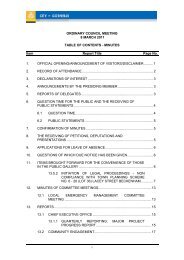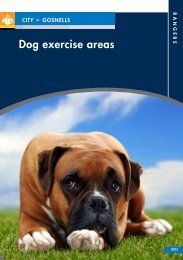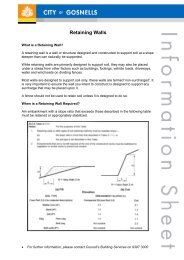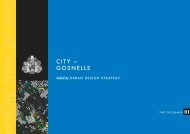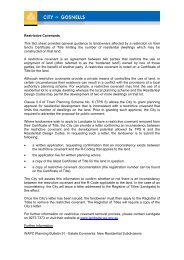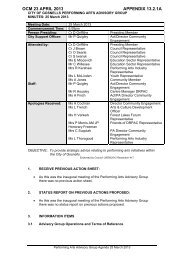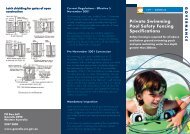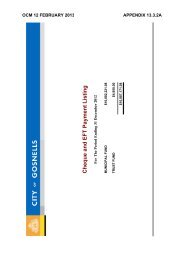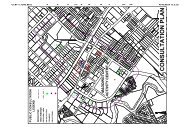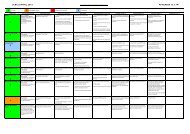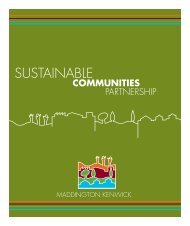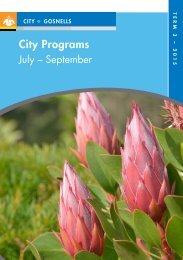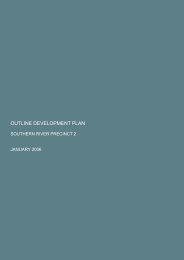Summary - City of Gosnells
Summary - City of Gosnells
Summary - City of Gosnells
You also want an ePaper? Increase the reach of your titles
YUMPU automatically turns print PDFs into web optimized ePapers that Google loves.
Wetlands Field Survey 98existing land uses within wetland buffer zones in the MKSEA should be audited to determine the activitiesthat are currently incompatible with the principles that apply to buffer zones (EPA, 2008; see above).Existing land uses incompatible with this should be regulated and slowly phased out. New or additionalinfrastructure or developments in the buffer zones should not be permitted.6.4.2 Ecological linkage corridors (greenways)Connectivity between areas <strong>of</strong> refugial natural habitat is anticipated to be one <strong>of</strong> the crucial determinants inbiodiversity survival in the future under fluctuating climatic conditions and increasing anthropogenic stresson the biota (DEWHA, 2009). Ecological linkage corridors (also referred to as greenways) are designed toincrease connectivity by linking high conservation value wetlands and bush reserves through any otherremnant native vegetation, parks and areas with minimal development that are known as ‘regional openspace’. The MKSEA is located in a strategic ecological area with regard to the opportunity to increase theconnectivity <strong>of</strong> BFS 387 (the most important Bush Forever Site on the SCP) with the large National Parks <strong>of</strong>the Darling Range and the Canning Regional Park. There were two ecological linkage areas proposed in thevicinity <strong>of</strong> the MKSEA prior to the current survey (by Government <strong>of</strong> Western Australia, 2000, and by DelMarco et al., 2004), both <strong>of</strong> which are considered below with regard to the findings <strong>of</strong> the current survey.6.4.2.1 The Yule Brook- BFS 387 GreenwayYule Brook and BFS 387 are part <strong>of</strong> a natural ecological linkage corridor between the Darling Range and theCanning River that was recognised by Government <strong>of</strong> Western Australia (2000). Yule Brook is a naturalecological corridor and this waterway was, over long periods <strong>of</strong> time, fundamental to the development <strong>of</strong> thecomplex natural habitats <strong>of</strong> the local alluvial fan and the biodiversity it supports. The brook also originallyenabled the dispersal <strong>of</strong> flora propagules from the Darling Range to the SCP. For fauna, it provided pristinequality water, diverse aquatic habitats and a sheltered, densely vegetated migration corridor.A number <strong>of</strong> indigenous heritage sites have been recorded in the vicinity <strong>of</strong> Yule Brook. Interestingly, thenatural history <strong>of</strong> Yule Brook parallels the indigenous cultural heritage <strong>of</strong> the area with regard to the creativeforce <strong>of</strong> waterways. The connections between the cultural and natural values <strong>of</strong> the area are very importantwith regard to the heritage values <strong>of</strong> the area and the potential interpretive and educational activities thatcould be developed in the area.The current survey identified additional areas adjacent to Yule Brook in the MKSEA that have nationallysignificantvalues that are not currently represented in BFS 387. These values included the EPBC-listedMuchea Limestone Threatened Ecological Community, a Declared Rare Flora Species (Eremophila glabrasubsp. chlorella), three Priority Flora Species, a suite <strong>of</strong> regionally significant flora, and vegetation <strong>of</strong> thevery poorly conserved Guildford Vegetation Complex (in good condition). The areas that include thesevalues should be managed as CCWs 7635, 7774 and 7780. The other remnant riparian vegetation <strong>of</strong> YuleBrook and any undeveloped floodplains adjacent to Yule Brook should be allotted a new UFI and managedas a REW to protect and enhance the existing wetland values and to support the restoration <strong>of</strong> the formerhydrological regime (i.e. seasonal inundation <strong>of</strong> floodplains) <strong>of</strong> this stream. A foreshore reserve <strong>of</strong> at least 50m in width (or wider in some areas) should be reserved adjacent to the wetlands above on either side <strong>of</strong> YuleBrook between Welshpool Rd and Roe Highway. Part <strong>of</strong> the function <strong>of</strong> the foreshore reserve should be tolink BFS 387 to the CCWs and REW adjacent to Yule Brook and support the restoration <strong>of</strong> the formerhydrological regime <strong>of</strong> this stream.Most <strong>of</strong> the other waterways connecting the Darling Range to the SCP in the Perth Metropolitan Region aremore degraded than Yule Brook and do not flank significant biodiversity conservation areas <strong>of</strong> the calibre <strong>of</strong>BFS 387. The restoration <strong>of</strong> Yule Brook represents one <strong>of</strong> the few remaining opportunities on the SCP tomaintain and reinforce the natural ecological connectivity between native vegetation and fauna habitats <strong>of</strong>the Darling Range, the Swan Coastal Plain and the Swan-Canning River system. To restore the role <strong>of</strong> YuleBrook as an active participant in the sedimentary and hydrological processes <strong>of</strong> the area and as a high qualityecological and biological linkage area, a number <strong>of</strong> objectives (including those listed below) should bepursued.Tauss, C. and Weston, A.S. (2010). The flora, vegetation and wetlands <strong>of</strong> the Maddington-Kenwick Strategic Employment Area.A survey <strong>of</strong> the rural lands in the vicinity <strong>of</strong> the Greater Brixton Street Wetlands. Report to the <strong>City</strong> <strong>of</strong> <strong>Gosnells</strong>, W.A. Version 18.04.10



